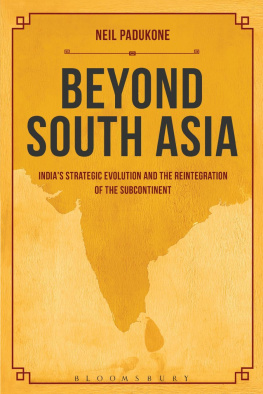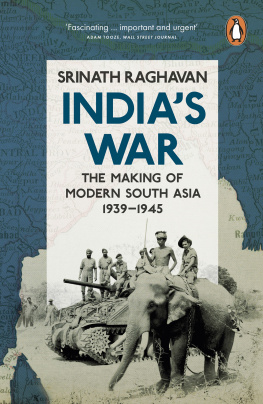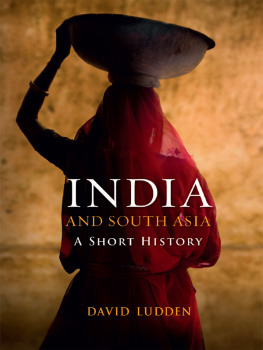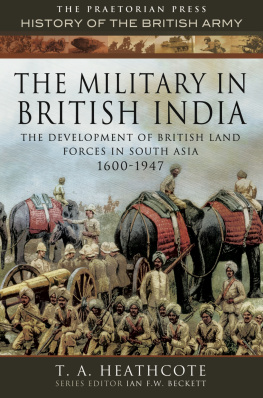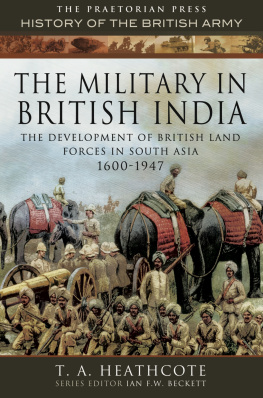The field of modern South Asian history has grown rapidly over the last fifteen years. A great deal of new writing has been encouraged by the subaltern studies school, which has had a major impact, not only within India, but in the historical discipline generally and within the field of post-colonial studies.
religious, revolutionary and social movements.
Subalterns and Raj
South Asia since 1600
Crispin Bates

First published 2007
by Routledge
2 Park Square, Milton Park, Abingdon, Oxon OX14 4RN
Simultaneously published in the USA and Canada
by Routledge
711 Third Avenue, New York, NY 10017
Routledge is an imprint of the Taylor & Francis Group, an informa business
2007 Crispin Bates
Typeset in Baskerville by
RefineCatch Limited, Bungay, Suffolk
All rights reserved. No part of this book may be reprinted or reproduced or utilised in any form or by any electronic, mechanical, or other means, now known or hereafter invented, including photocopying and recording, or in any information storage or retrieval system, without permission in writing from the publishers.
British Library Cataloguing in Publication Data
A catalogue record for this book is available from the British Library
Library of Congress Cataloging in Publication Data
Bates, Crispin, 1958
Subalterns and Raj : South Asia since 1600 / Crispin Bates.
p. cm.
Includes bibliographical references.
1. South AsiaHistoryTextbooks. I. Title.
DS340.B385 2007
954.03dc22
2006101852
ISBN10: 0415214831 (hbk)
ISBN10: 041521484X (pbk)
ISBN13: 9780415214834 (hbk)
ISBN13: 9780415214841 (pbk)
Contents
Subalterns and Raj was conceived as an introductory text for my own students and others starting out on the study of the modern subcontinent of South Asia, covering key events, together with some marginal and ignored aspects of the same, from Mughal times right up to the present. Its first publication, in a year that coincides with the 150th anniversary of the Indian uprising of 1857 and the 60th anniversary of Indian independence, offers a particularly appropriate time for reflection upon the connections between the history of the recent past and that of the present, which it is hoped this volume might encourage and permit. The volume was also conceived as offering something of a riposte to the sentimental, colonialist recollections of the British raj in India, always beginning in 1757 and ending in 1947, which still plague popular history writing in Britain. Such writing, which pays attention only to feats and never failures, obscures the British conception of their real place in the world and encourages the irresponsibilities of foreign policy in the present. It is a perpetual myopia, writ large by national prejudice to which all countries are victim, though some rather more than most. I have endeavoured as far as possible to correct this by a serious and sincere reflection of subaltern and South Asian nationalist perspectives on the history of the subcontinent. At the same time, I have tried to hold onto what for most readers will be the recognisable signposts of South Asian history, most often deriving from the machinations of elites. This is unavoidable, but I have sought to maintain throughout a critical perspective, combined with a sympathy for the victims of history, which hopefully carries the narrative through some of the knottier issues of interpretation. The contemporary history chapters were the most difficult to write, since there is nothing like the same volume of secondary historical material that might assist in historicising events and putting them into some sort of perspective. There is a heavy reliance here on the work of political and social scientists, which may all too soon become out of date. It is nonetheless hoped that by providing a largely narrative survey of (primarily political) change in the subcontinent that crosses over the 1947 divide, together with copious references to further reading, this volume will help guide students of history, politics and related disciplines, and also the general reader who seeks to understand and contextualise historically the problems and dilemmas of the present.
Even as I was writing this book the names of principal cities and even states in) for a delightful correspondence and access to his magnificent collection of photographs, too few of which I was able to use. The maps in this book are nonetheless drawn approximately for illustrative purposes alone and should not be taken as accurate interpretations of geographic or political features. By way of apologies, I necessarily regret the paucity of coverage given to Sri Lankan history prior to 1948 and the neglect of minor South Asian states such as Bhutan and Nepal, to which only passing reference is made. For reasons of space the stories of Pakistan and Bangladesh are also entirely enfolded into the larger states of which they were a part prior to their independence. Such compromises are unavoidable in a volume of this nature, but will hopefully not limit its utility.
The writing of this book took far longer than originally planned and was formed at various times in various places. I am especially grateful for the comments I have received from readers at different stages. For early input I am indebted to the patient reading and comments of David Hardiman and Subho Basu. Later on I received invaluable corrections and suggestions from Satadru Sen, Roger Jeffery and David Ludden, as well as several anonymous independent referees commissioned by Routledge. I also received a helpful reminder of the fire in the blood of nationalists in the late 1930s from a lengthy and inspiring conversation with Gyan Pandey, which helped in the reworking of the chapter on that period. For other chapters I am grateful for the thoughts and comments of Nira Wickramasinghe, Harinda Vidanage, David Washbrook and Suranjan Das, and especially for the assistance of Markus and Umbreen Daechsel and Sudhir Chandra, who provided the translations of Ustad Daman and Ghalib, respectively. I am heavily indebted to Marina Carter for her encouragement, suggestions and careful reading and re-reading of every chapter in the book from its very inception until the end. My own dear parents, and the Vaudescal and Ikegame families have all borne the afflictions of this book, for which I am hugely grateful. However, I must thank Aya Ikegame above all for her understanding and support in the final stages, without which it might not have been completed.




